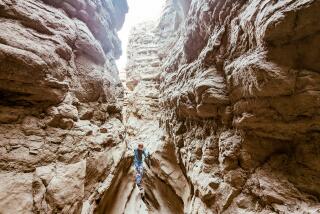Signal Hill: Beacon for Unconditioned Hikers
- Share via
Signal Hill has long been synonymous with oil. Atop this Long Beach prominence, a great oil field was discovered in 1921. Alamitos No. 1, as the discovery well was known, produced 600 barrels a day. Soon Signal Hill was covered with derricks, which produced 250,000 barrels a day.
The hill is a quieter place now, though a number of active wells are still pumping black gold. Because Signal is the only hill for miles around, it has long been a popular conditioning walk for hikers.
Sierra Club outings leaders report that often more than 100 hikers turn out for evening strides around the hill. Signal Hill is anything but a natural environment, but the great views of harbor and city and the camaraderie of the trail usually add up to a fun trip.
During the 1840s, the hill was the property of rancher John Temple, who called his spread Los Cerritos--”Little Hills.” The hill was renamed in 1889 when the Coast Survey of 1889 used it as a signal point.
Signal Hill and its geologic cousins to the north--Baldwin Hills--were uplifted as a result of activity from the Newport-Inglewood Fault Zone. One result of this fault activity was that oil accumulated beneath various anticlines, or domes of rock.
Although Signal Hill achieved worldwide recognition for the petroleum and profits it produced, the hill never has been known as a model oil field. Haphazard development and excessive drilling led to an ugly and dangerous environment. Politics played a part in this. While surrounded by the city of Long Beach, two-square-mile Signal Hill managed to incorporate as a separate city. Signal Hill’s borders approximated the borders of the oil field; its cityhood was an attempt to avoid high taxes and environmental restrictions.
Signal Hill--the mountain--has been cleaned up some since its heyday, and its slopes now host more houses than oil wells. Still, day hikers should use caution, avoid drilling equipment and respect “No Trespassing” signs. There isn’t a single path around the hill; rather, you improvise a route on Signal’s dirt and paved roads.
To fully enjoy the great clear-day views, bring along binoculars and a city map.
Directions to the trailhead: From Interstate 405 (San Diego Freeway) in Long Beach, take the Cherry Avenue/Signal Hill exit. Head south on Cherry Avenue half a mile to Willow Street. Turn left and after a mile, make a right on Redondo Avenue, then right on aptly named Hill Street. Proceed to the base of Signal Hill. Depending on your time and/or inclination, you can park at the base of the hill or closer to the top.
The hike: Follow Panorama Drive or the dirt road below it in a counterclockwise direction. You’ll pass oil wells, get a view to the north of the San Diego Freeway, the planes arriving and departing from Long Beach Airport and many square miles of suburbia. Eucalyptus and palms trees line the up-and-down dirt roads. Lemon grass and California poppies add a little color to the ugly hillsides.
Your route crosses Burnett Street and you join a dirt road on the west side of the hill. Growing on this slope is a zany mixture of flora--banana palms and California fan palms, Canary Island pines, lemonade berry and brittle bush.
Only the hawks circling overhead have a better view. The view west takes in the Palos Verdes Peninsula. Catalina Island, 30 miles away, is visible on a clear day.
Looking south and west you can identify the Queen Mary and its three stacks and count a number of man-made oil islands. Dominating the coast is the massive Los Angeles/Long Beach harbor complex and the tall cranes used for loading containerized cargo. Several bridges spanning the harbor also are in view, including the Vincent Thomas Bridge, which connects San Pedro and Interstate 110 (Harbor Freeway) with Terminal Island.
After circling the hill and seeing the sights, you’ll end up at the corner of Hill Street and Temple Avenue. Here you’ll find the plaque commemorating the success of the Southland’s oil pioneers and Alamitos No. 1: “. . . a success which has, by aiding in the growth and expansion of the petroleum industry, contributed so much to the welfare of mankind.”
More to Read
Sign up for Essential California
The most important California stories and recommendations in your inbox every morning.
You may occasionally receive promotional content from the Los Angeles Times.













